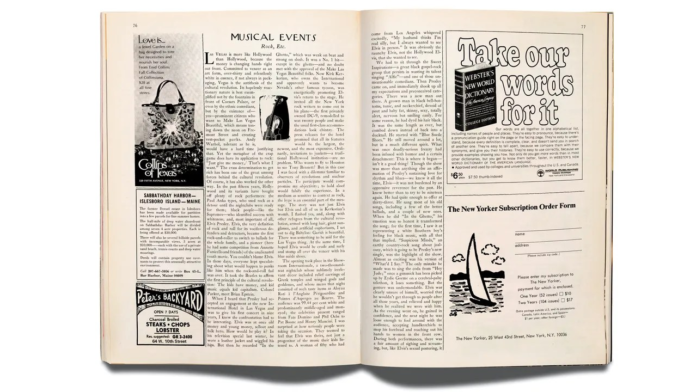The Fascination of Elvis’s Resurrection
Elvis Presley, a name that often evokes strong reactions, has long been an emblem of American culture. For many, his music remains iconic; for others, he embodies a complex cultural mythology. Yet, what draws curiosity beyond the surface is the theme of resurrection—how the narrative of a figure long boxed away can spring to life again. Ellen Willis’s pivotal 1969 review captures this moment perfectly, providing a glimpse into Elvis’s reemergence as a vibrant performer, revitalized after years in the shadows.
Ellen Willis: A Unique Perspective
Ellen Willis, known as The New Yorker’s first pop-music critic, had a distinctive voice that balanced skepticism with an openness to delight. In her writings, she often navigated this intersection, bringing a fresh perspective to the cultural icons of her time. Her perspective on Elvis, written on the cusp of his comeback, encapsulates the ambivalence and excitement of witnessing a figure rejuvenate in the spotlight.
Elvis in 1969: A Man Reborn
By the summer of 1969, Elvis was not the same young man who had once revolutionized rock and roll. He had spent nearly a decade away from the concert stage, losing himself in film roles and soundtracks that pulled him away from live performances. Yet, that year marked a pivotal turnaround. His comeback special, filmed in June and aired in December, reignited his career and set the stage for his return to Las Vegas. Willis described this transformation as less a simple resurrection and more as a reclamation of his identity.
The Las Vegas Stage: A Symbol of Revival
Las Vegas in the late 1960s was more than a mere stopover; it was a cultural phenomenon. Willis described it as “more like Hollywood than Hollywood,” a stage where stars were reborn in the public eye. For Elvis, conquering this glittering venue was crucial to affirming his comeback. His performances were not just a return to form but a statement—a proclamation that he was back and ready to reclaim his throne.
A Moment of Genuine Marvel
Willis’s observations transformed as she witnessed Elvis take the stage for the first time in nearly a decade. What began as a mild confusion about his updated appearance—his new physique and altered hairstyle—transitioned into genuine admiration. Despite the superficial changes, she noted his performance style had matured. Elvis was no longer trying to relive his youth; instead, he embraced the growth that came with age. This realization marked a turning point in Willis’s review, transitioning her from mere observer to an enthralled participant in the experience.
Capturing a Complex Appeal
The depth of Willis’s analysis lies in her keen understanding of what made Elvis such a multifaceted performer. She articulated that when he sang “In the Ghetto,” it went beyond mere entertainment. For the first time, she saw the reflection of a white Southern boy grappling with the layers of black music—a realization that deepened the emotional weight of his performance. This intersection of identity, culture, and music showcased Elvis as a performer capable of containing vast historical and emotional currents.
The Romanticism of Performance
Willis’s writing exemplified her ability to lead readers through a transformative experience. She didn’t just analyze Elvis’s performance; she invited readers to witness her journey of finding appreciation for someone she initially regarded with skepticism. Her brief yet impactful review underscores the beauty of recognizing an artist’s evolution—not by stripping away romance but by embracing its complexity.
Elvis as a Blank Slate
Elvis’s resurgence in 1969 highlighted a broader cultural phenomenon: the blank-slate pop star. Over the decades, many artists, including contemporaries like Taylor Swift, have taken on this role, becoming vessels for societal emotions and beliefs. What set Elvis apart was his mastery over the projections placed upon him; he didn’t merely embody these narratives—he cultivated and reshaped them. This ability makes critical examinations of his work all the more vital, revealing the interplay between the artist and the audience’s expectations.
A Legacy Still Alive
Willis’s reflections on Elvis serve as a reminder that his story is far from over. Even in moments of perceived decline, the spark of creativity and complexity can reignite a legacy. Her ability to convey surprise and transformation illustrates the profound impact of witnessing an artist who, despite societal expectations, remained vibrantly alive, continually evolving as a performer.
